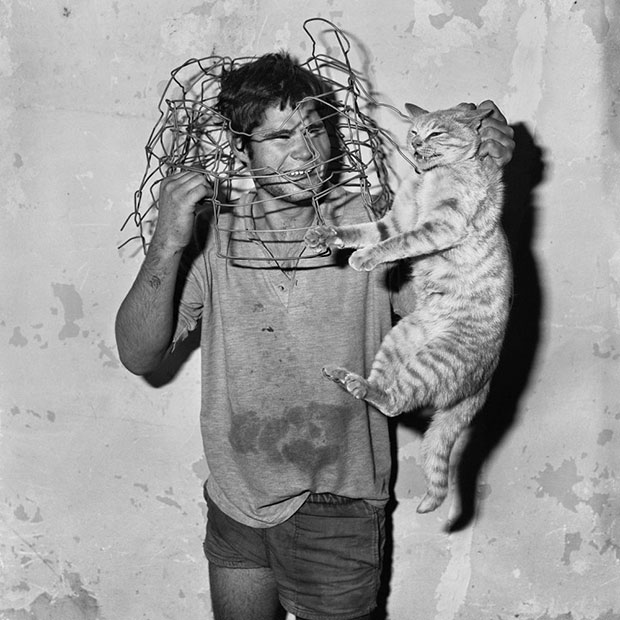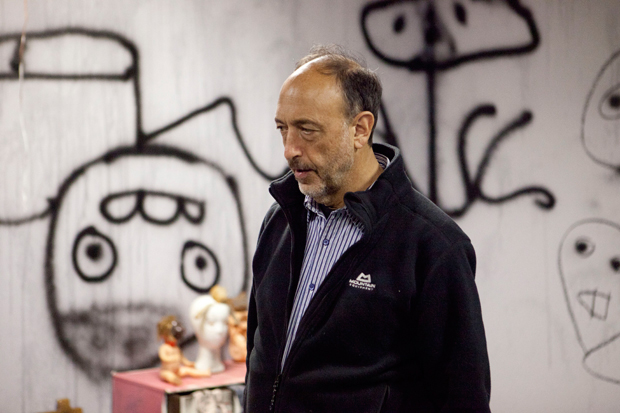
Roger Ballen goes back to Outland #4
1998 photograph Cat Catcher conceals a tale of witch doctors, marginalised living and our destructive nature
This is one of my most iconic photographs," says Roger Ballen flicking through our newly updated book Outland which features photographs he took in South Africa in the late nineties and early noughties. "I’ve known this person for 20 years, I still see him around. Occasionally I pick him up in my car if I have the time. I always know where he wants to go. He goes into town, to this area where there are witch doctors."
Outland is an intense collection of photographs, many of them powerful psychological portraits which peer deeply into the human condition as experienced on the margins of the modern world. They make for an enigmatic, occasionally absurd, but always profound tableaux. Anyway, back to our friend in the photograph above. Ballen takes up the story.
"I often see him walking round with his burlap bag. And what he does, believe it or not, is he finds and catches cats. And he puts them in this bag. And he goes into town and he gives the witch doctors the bag full of cats. They weigh the bag and they kill the cats and they take the tail and the feet and they use them for witch doctor stuff. He gets paid per kilogram for this stuff. He’s been doing it for 20 years.
"Like I say, it's one of my most iconic shots. First of all from a formalistic point of view. There’s the relationship of the man’s mouth to the wire mask round his face to the cat - they’re really linked. Look at the relationship between his shirt and the wall, and look at the shadow around the tail. During this time I had a Metz flash attached to the camera. It was an L shape, which meant that when I took the picture the flash would create a shadow on the right hand side of the picture – it was very strong and direct and the pictures would have very harsh shadows as a consequence.
"The shadow in the history of art has layers and layers of metaphor. So the issue when you take pictures like this is the shadow has to be linked in a very concrete way to the rest of the photograph. Here it's the relationship between so called concrete reality and obscure reality. It almost goes back to childhood. What part does the shadow play? Joseph Campbell and Jung talk about the shadow-self which is obscured. A shadow is a shadow but if it’s visually apparent and visually linked to the opposite of what a shadow is then it brings out many issues and metaphors.

"I don’t really try to challenge the people I shoot in any real way. With this guy I feel that’s what he does and how he lives. The main reason he does it is because it’s how he survives. Does he think about the cats? Maybe he does, maybe he does not. He loves animals, he has cats in his house. But I don’t really try to probe into people’s lives unless they ask my advice.
"But it’s an important point. I actually feel a deep guilt and I realize that I’m not actually any better than this guy. I’m having a chicken dinner tonight, I’m wearing leather shoes, I take planes to every country on the planet. I’m messing up everything and so is nearly everybody on the planet. Our species is ravenous. I’m an exploiter. I’m destroying the world. Everyone reading this is destroying the world too. Everything humanity does is destructive of nature. So I don’t actually get into it with him because to me he’s just a symbol of what exists out there and in fact, the more wealthy you are the more destructive you probably are.
"The best example of this is the way modern society lives. Like if somebody sat on the street and killed a chicken the police and the SPCA would be here in five seconds. There would be people surrounding them and big arguments on the street. The police would be called and that person would be arrested within ten minutes. But go to any big supermarket, you’ll see fifty metres of dead flesh sitting there, and plenty of people milling around the dead flesh. Not one person will think about it."
Check back for the next story in our series or cut to the chase and get the book. You'll find it here. And if you like the look of Roger Ballen's work and the way he describes it, you'll find some great Ballen pieces over at Artspace.